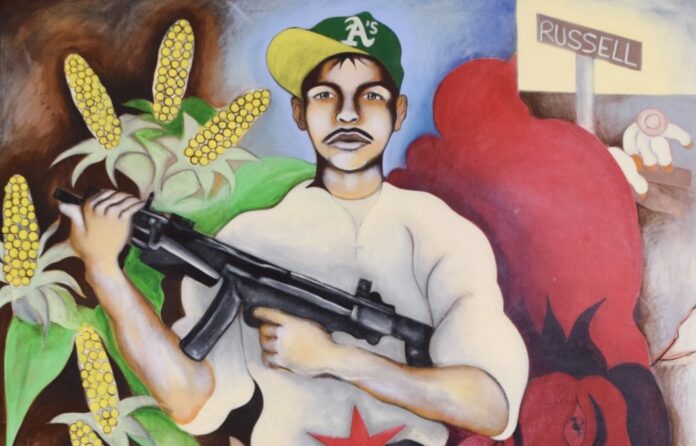Artist Héctor Muñoz-Guzmán is an artist at his core, with a deep passion for creating colorful imagery that represents his culture.
Muñoz-Guzmán doesn’t come from generational wealth, his grandparents having grown up on ranches in rural Mexico. But, he says that not having been born with everything in the palm of his hand urged him to work hard for his achievements. His gratitude for those who have helped him on this path are evident in our conversation.
“Ultimately, I make art to keep peace within myself and to have connection to my family. It’s what keeps me grounded,” Muñoz-Guzmán told 48hills.
The artist is a third generation South Berkeley resident, his family having gradually relocated from Tepatitlán, Jalisco, seeking better opportunities.
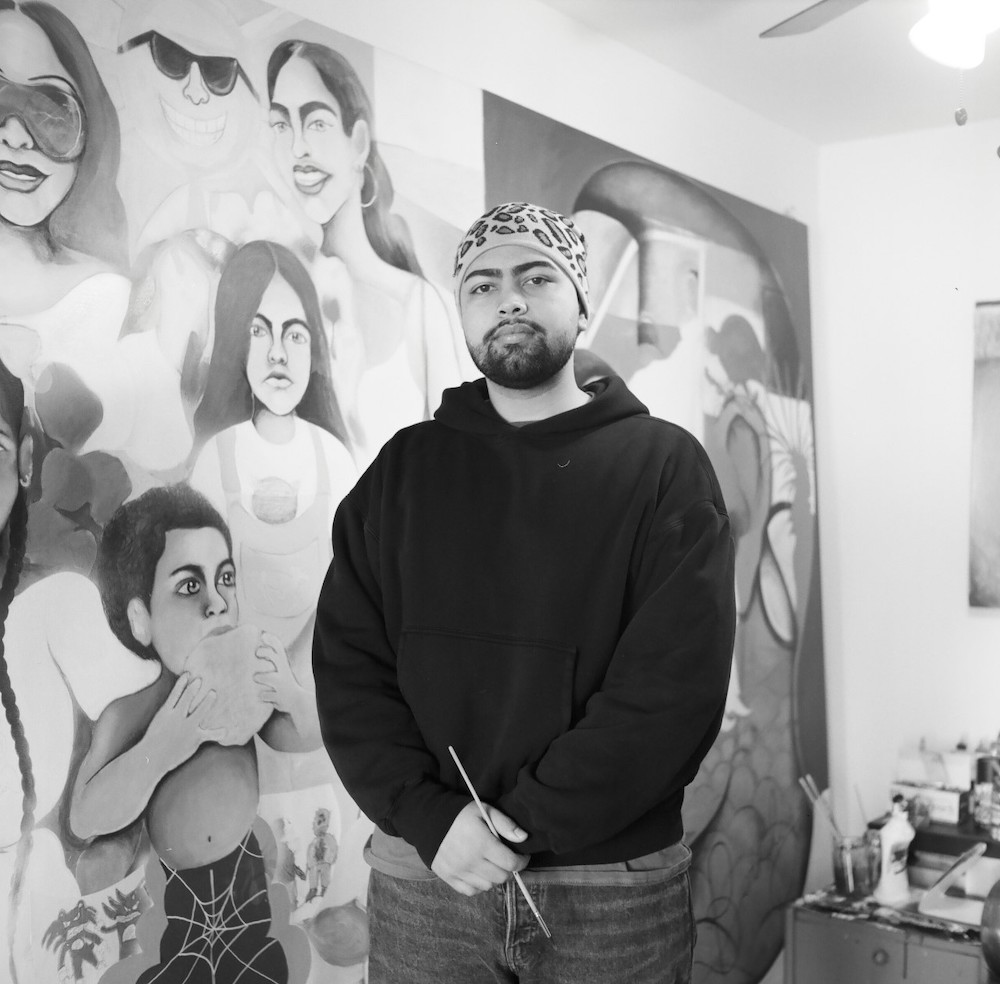
One of Muñoz-Guzmán’s biggest inspirations is his mother Brisa. He calls her his “superhero.”
“She is the definition of resilience. She came to this country at 14, not knowing a lick of English, and raised me and my older sister by herself without passing down her traumas onto us. She modeled that where you come from does not determine where you will end up,” he said.
Muñoz-Guzmán describes how his mother worked restaurant jobs to keep a roof over their heads, while offering her children a safe space to grow. She supported her son even though she didn’t fully understand the career path he wanted as an artist.
“When I moved to New York City at the age of 17 to attend Parsons School of Design, I only had 40 dollars to my name. Without my mother’s guidance and reassurance, I would not have been able to conquer that new stage in my life,” he said.
His mother is not the only person who has provided crucial support. While attending elementary school in Berkeley’s Cragmont neighborhood, Muñoz-Guzmán had an art teacher named Joe who recognized his talent, giving him special treatment and better art materials.
“I really appreciated this because my mother was not in the position to buy me supplies,” the artist said.
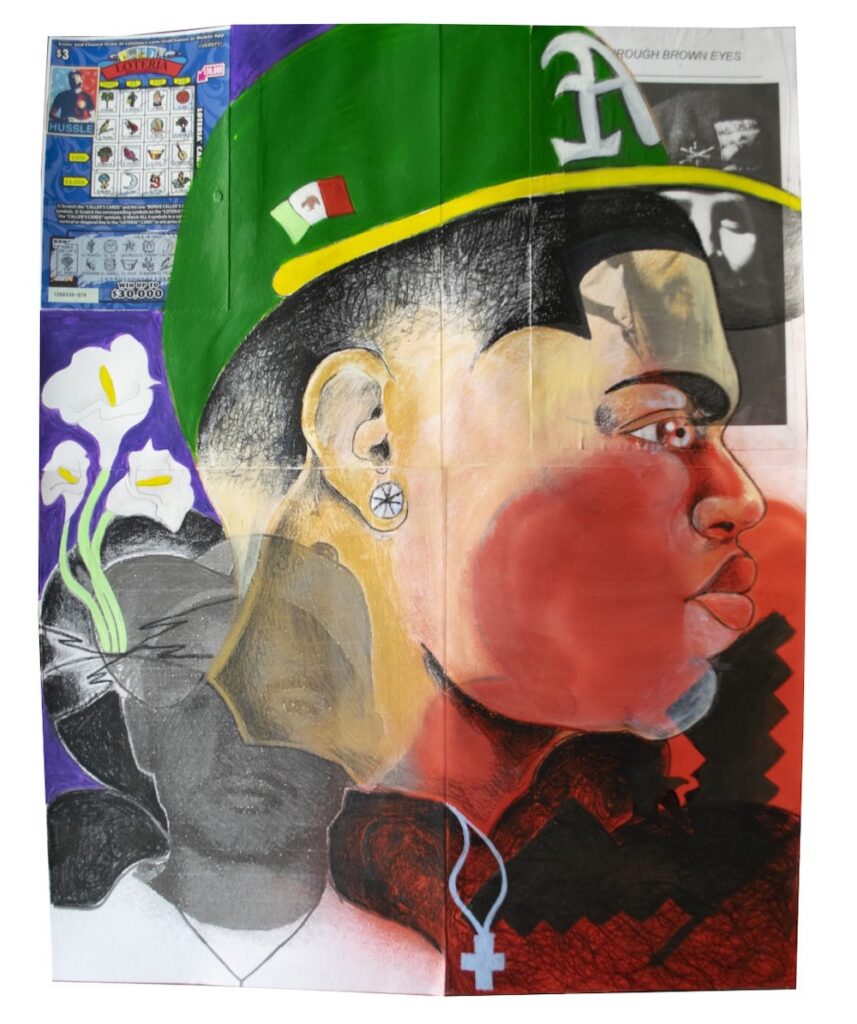
Growing up in the East Bay exposed him to graffiti and street muralism. At Berkeley High School, he was mentored by Kimberly D’Adamo in creating a body of work centered around a research topic.
Muñoz-Guzmán eventually attended both Parsons School of Design in New York and Rhode Island School of Design.
After leaving his mother’s nest, he knew he needed to find his own way and hold himself accountable to achieve his dreams. Now, he lives with his girlfriend and they foster their own nurturing space.
“It has helped me thrive even more. Being an artist, when you have a supportive life partner that believes in you, makes the journey so much easier,” he said.
His time in the painting program at RISD was productive and transformative. He honed his techniques with oils, light, negative space, color theory, and drawing the human figure through deep observation. His focus was portraiture, with an emphasis on Mexican culture.
Herein lies the soul of his work. Mexican icons like Emiliano Zapata, Corky Gonzales, and Dolores Huerta are a source of its pulse—strong leaders with a determination to serve their people. Artists such as Diego Rivera, Jose Clemente Orozco, and David Alfaro Siqueiros remind Muñoz-Guzmán of the importance, the unique voice of the Mexican revolutionary painter. He is aware of his powerful cultural history, and feels a duty to represent it.
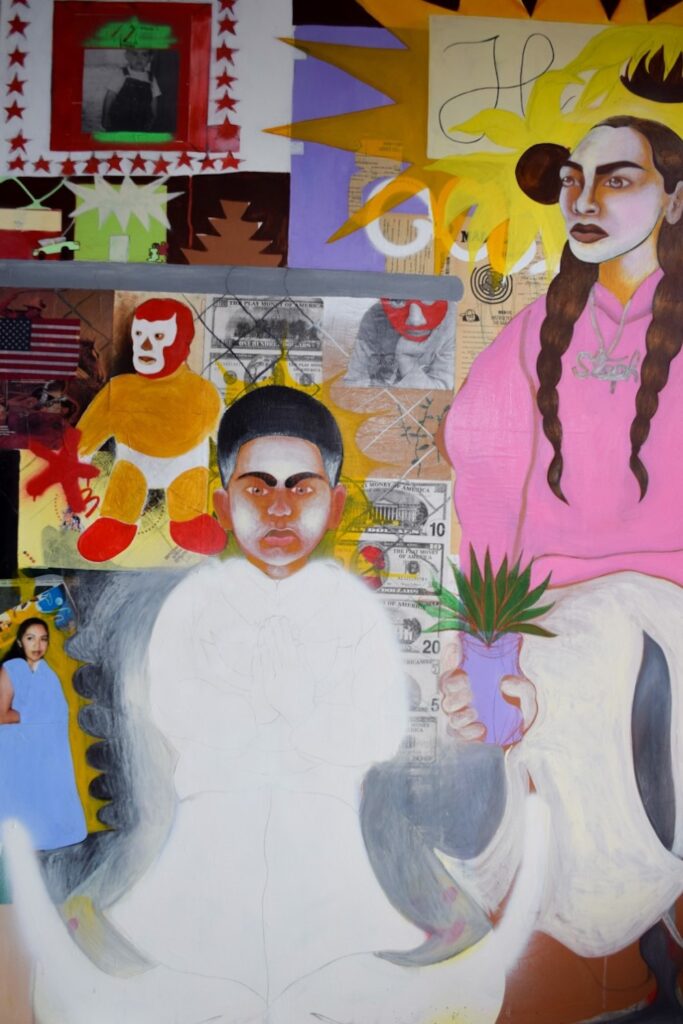
Bold color is also a factor in Muñoz-Guzmán’s work that is not to be overlooked.
“I love the full vibrancy of the color wheel. I love colors straight out of the tube. One of the biggest critiques at RISD was that my paintings were too colorful, but it’s just what I’m drawn to,” he said.
On a typical morning after feeding his cat, Montezuma, Muñoz-Guzmán begins painting. He treats his all-day studio sessions as a full-time job. He stretches and prepares his own canvases with multiple layers of gesso, sanding and wet sanding in between, then adds mid-tone or base color that isn’t white. Referencing compositions from his small collages and drawings as a guide for large paintings, Muñoz-Guzmán sketches onto the canvas with chalk and color blocks with spray paint. Once he begins applying acrylic paint, he focuses on one color at a time, layering with oil paint in areas he wants to appear smoother.
“Since I have already done all the thinking in the smaller works, I approach the larger piece as shapes, layering all media to create the final image,” he said.
His methods are a holdover from his college days, when he had to rely on less expensive materials.
Peers have been gifts in his development as a creative. Before meeting artist Sophia Yemisi-Adeyemo at RISD, his work depicted a lot of violence. But with her guidance, he realized he was perpetuating negative stereotypes that the mainstream world already inflicts on people of color.
“Sophia encouraged me to go for a softer approach with subjects and introduced new color techniques,” he said.
His roommate at RISD, Patricio “Pachi” Muruchu also played a key role in his artistic upbringing impressing upon Múnoz-Guzmán the importance of knowing one’s history and keeping traditions alive. Muruchu has since become a lifelong friend.
“My goal is to put Mexican people on the highest pedestal to help change the narrative of perception. We are more than just our suffering,” Múnoz-Guzmán said.
Of course, there’s much more to this story than mentors and natural talent. In a period at RISD of extreme creativity, high energy, and heightened senses, he consistently found himself in dream-like states. This built to his first bipolar episode, which caused Muñoz-Guzmán to be admitted to Butler Hospital. Muñoz-Guzmán believes the condition was activated from an immense amount of financial and social stress.
“I thought everyone wanted to kill me, I thought I was being watched and that everyone was an actor. At moments I wanted to die, sadness filled my heart, and I would not sleep for days at a time,” he said.
He felt imprisoned, but after a month and a half in which he experienced more than three episodes, he was released with an official diagnosis: Bipolar 1. He went from feeling every emotion to total emptiness, and could no longer create art.
He no longer felt in touch with his community, but recognized that his people’s story had been kept from him his entire life. He began checking out as many books as he could on Mexican history, social movements, and race theory.
“The experience of so much anger and frustration from learning why my people were suffering was painful—I would just cry in those moments,” he said.
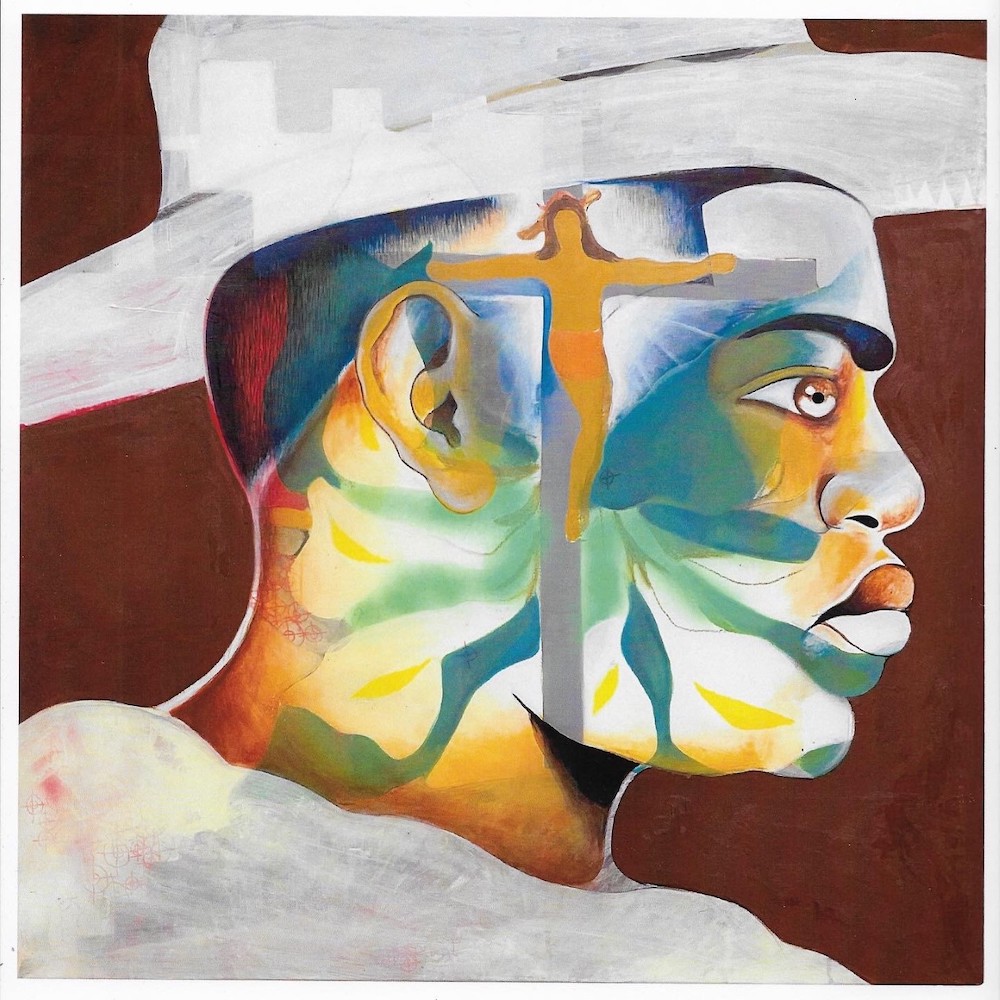
He began to feel that most curriculum at RISD brushed his people’s importance within art history to the side. Even though he had made it to one of the best art institutions in the world, he felt like he had to speak for his whole race in every classroom.
“I was climbing up the social art ladder but simultaneously growing farther and farther away from my own community. I think that’s enough to drive someone insane,” he said.
At 21, his diagnosis and disillusionment led him back to Tepatitlán. He had given up on himself and his art and fell into a depression. But in a positive turn of events, he was introduced to new ways of medication and healing by a Mexican doctor. He was able to slowly pull himself back up, and begin creating art again.
Muñoz-Guzmán started new paintings, and apprenticed with Tepatitlán muralist Guadalupe Rios, who reassured him he held the spirit of the work. Eventually, he bought a plane ticket back to the Bay Area.
“Living in Mexico made me realize the privileges I have living in the United States, especially freedom of speech. But I went to Mexico in search of new treatment and got it. I lived as a worker and really connected with Mother Earth. It humbled me, going from an elite art school to digging six-foot holes in the agave fields,” he said.
Muñoz-Guzmán has now exhibited work in Massachusetts at Fall River MoCa; in New York at Bureau, a gallery in the Lower East Side; and at Studio 101 with Amor Prohibido, in the Garment District of Los Angeles. He is now concentrating on showing his paintings locally and connecting to the greater Bay Area artist community.
In full swing for 2023, Muñoz-Guzmán is participating in two group shows: “Pertenecer: To Belong” at Movimiento de Arte y Cultura Latino Americana (MACLA) in San Jose, which is on exhibit through March 19; and at Pt.2 Gallery in Oakland in early April.
He is working on a piece through the Individual Artist Grant project of the Berkeley Civic Arts that is slated to be completed in April. The work is a seven-panel, seven by 24-foot painting in acrylic, chalk, and oil paint, depicting Muñoz-Guzmán with multiple members of his extended family in tribute to his home neighborhood of South Berkeley.
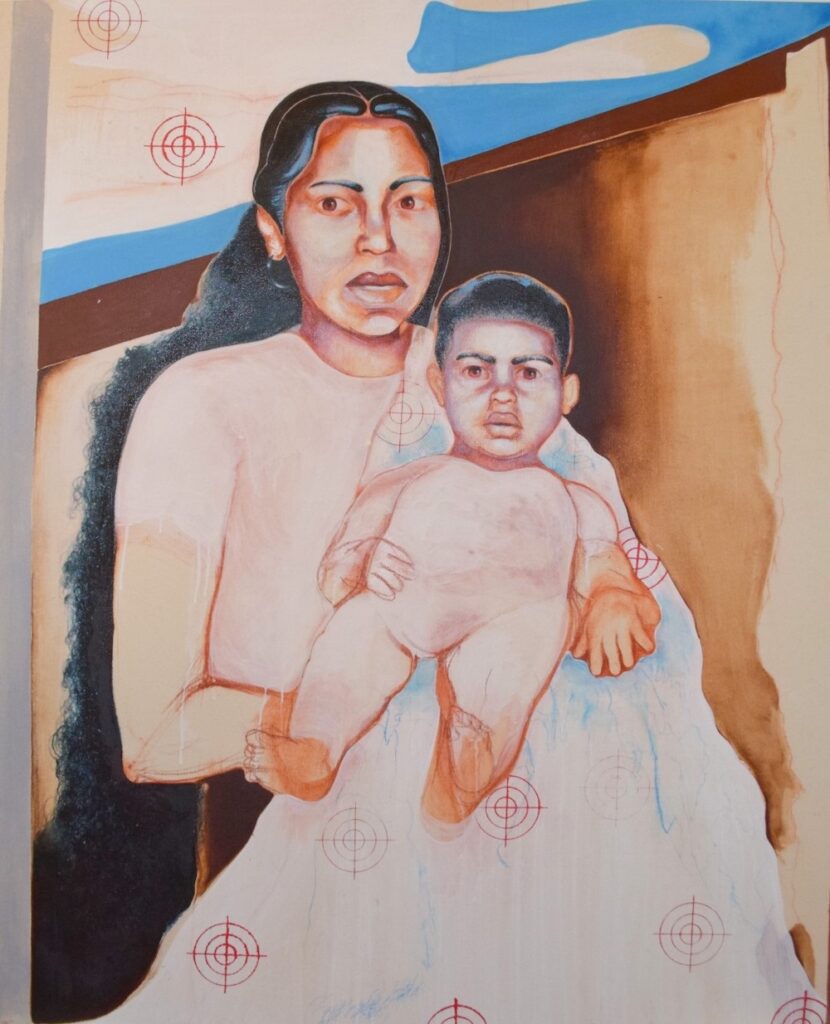
Giving back to community, he has taught at the Richmond Art Center and is currently an instructor for Creative Growth in Oakland, work the artist says brings him joy. He also has a forthcoming book titled Brown Eyes From Russell Street to be published by Sming Sming Books, which will feature an overview of his progression as an artist through photographs, interviews, and more.
Héctor Muñoz-Guzmán wants people to remember where they come from. When he paints, he says, he channels that inner six-year-old boy on Russell Street in Berkeley who drew on everything he could get his hands on. He encourages all people of color to actively seek out their history in order to help us love ourselves, our communities, and ultimately become more well-defined individuals.
“We have a rich multicultural background with so many influences that make up our unique Mexican identity. We come from kings and queens, a culture of wealth, strong spirituality, agriculture, astronomy, and a strong connection to Mother Earth. That, we should be proud of and embrace,” he said.
He adds that we should always remember that our dreams are not as far away as we think. And that positive representation goes a long way.
“You never know who you’re going to inspire or the lives you will save,” he said.
For more information on Héctor Muñoz-Guzmán, visit his Instagram profile.

